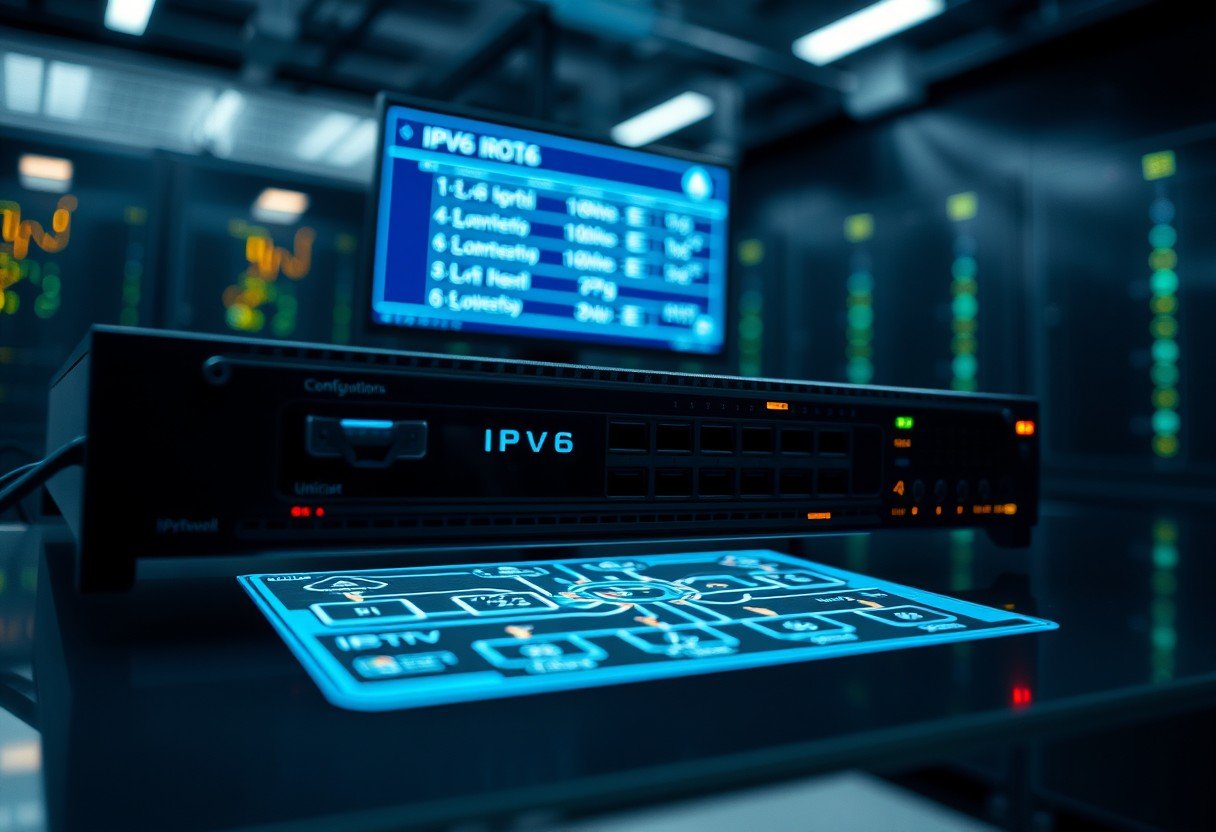Configuring the ipv6 unicast-routing command is a fundamental step for any network administrator working with modern internet protocols. This single command unlocks your router’s ability to forward IPv6 packets, essentially turning it into an active participant in an IPv6 network. Understanding how and why to use this command is crucial for building scalable, future-proof networks that can handle the ever-growing number of internet-connected devices.
What Exactly is ipv6 unicast-routing?
Think of the ipv6 unicast-routing command as the master switch for IPv6 traffic on your router. By default, a router might have IPv6 enabled on its interfaces, allowing it to be an endpoint, but it won’t actually forward or route packets between different networks.
When you enter this command in global configuration mode, you are telling the device to actively process and forward IPv6 packets based on its routing table. It enables the router to make intelligent decisions about where to send IPv6 traffic, which is its primary job.
Without this command, your router cannot perform routing for IPv6, rendering features like static routes or dynamic routing protocols for IPv6 completely useless. This is a critical distinction; the router can have IPv6 addresses but cannot route until you explicitly tell it to.
The Core Impact on Your Router’s Functionality
Enabling IPv6 unicast routing dramatically enhances a router’s capabilities. It transforms the device from a passive participant into an active IPv6 traffic director. This is the foundation for building a true IPv6 network.
One of the most important aspects is that it allows the router to support various IPv6-specific protocols. This includes the Neighbor Discovery Protocol (NDP), which is essential for devices to discover each other on a network, and dynamic routing protocols like OSPFv3 and EIGRP for IPv6.
A common concern for network engineers is how this affects existing IPv4 operations. Remarkably, enabling ipv6 unicast-routing has no negative impact on IPv4. Routers are designed to operate in a dual-stack environment, meaning they can handle both IPv4 and IPv6 traffic simultaneously and independently. This allows for a seamless and gradual transition to IPv6 without disrupting current network services.
How this Command Affects Network Performance
When you enable IPv6 routing, you are not just adding a feature; you are tapping into a more efficient protocol. The design of IPv6 can lead to better network performance in several ways. For instance, IPv6 headers are simpler than IPv4 headers, which can result in faster processing by routers.
The vast address space of IPv6 also eliminates the need for Network Address Translation (NAT), a process that can introduce latency and complexity. With direct end-to-end connectivity, data transmission becomes more straightforward and efficient.
While enabling a new process technically uses router resources like CPU and memory, modern networking hardware is more than capable of handling dual-stack operations without performance degradation. In fact, well-configured IPv6 networks often see benefits:
- Slimmer Routing Tables: The hierarchical nature of IPv6 addressing allows for better route summarization, leading to smaller and more efficient routing tables.
- Reduced Broadcast Overhead: IPv6 uses multicast instead of broadcast, which reduces unnecessary traffic and frees up bandwidth on local networks.
- Auto-configuration: Features like Stateless Address Autoconfiguration (SLAAC) simplify network management and reduce manual configuration errors.
Troubleshooting Common Configuration Issues
Even with a simple command, issues can arise. If you have enabled ipv6 unicast-routing but traffic is not flowing, there are a few common misconfigurations to check. Often, the problem lies not with the command itself but with the surrounding setup, such as incorrect IPv6 addresses on interfaces or missing routes.
The first step in troubleshooting is always verification. Ensure the command is present in your running configuration and that your interfaces are up and have valid IPv6 addresses assigned. Using built-in diagnostic tools is the fastest way to pinpoint the problem.
Here are some essential commands that can help you diagnose and resolve IPv6 routing problems:
| Command | Purpose |
| show ipv6 interface brief | Quickly shows the status and IPv6 address of all interfaces. |
| show ipv6 route | Displays the IPv6 routing table to verify if routes are learned correctly. |
| ping ipv6 [destination-address] | Tests connectivity to another IPv6 device to isolate the problem area. |
| show ipv6 protocols | Shows which IPv6 routing protocols are configured and running. |
By using these commands, you can systematically check connectivity, interface status, and the routing table to find out why your IPv6 packets are not being forwarded as expected.
Best Practices for a Secure IPv6 Deployment
Simply enabling IPv6 routing is not enough; you must also secure it. IPv6 introduces new security considerations, and it’s vital to implement best practices from the start to protect your network from potential threats.
Your security strategy should focus on controlling traffic flow and preventing unauthorized access. Do not assume your existing IPv4 security measures will automatically protect your IPv6 traffic. You need to configure security policies specifically for IPv6.
Start by implementing IPv6 access control lists (ACLs) to filter traffic entering and leaving your interfaces. This is your first line of defense. Additionally, secure your routing protocols to prevent malicious actors from injecting false routes into your network. Regularly reviewing and updating your security policies is essential to address new vulnerabilities as they emerge.
Frequently Asked Questions about ipv6 unicast-routing
What is the main purpose of the ipv6 unicast-routing command?
This command’s primary purpose is to enable the global IPv6 routing process on a router. It allows the device to build an IPv6 routing table and forward IPv6 packets between its different interfaces.
Does enabling ipv6 unicast-routing affect my IPv4 traffic?
No, it does not interfere with existing IPv4 configurations or traffic. Routers that support both can run them in a dual-stack mode, processing both types of packets simultaneously without any conflict.
What happens if I forget to enable this command on my router?
If you do not enable this command, the router will not forward any IPv6 packets between networks. It can still have IPv6 addresses on its interfaces for management, but it will not perform its core function of routing for IPv6.
Are there any performance drawbacks to enabling IPv6 routing?
Modern routers are designed to handle both IPv4 and IPv6 with minimal performance impact. In many cases, the efficiencies of IPv6, such as simpler headers and no need for NAT, can lead to improved overall network performance.
Which IPv6 features require this command to be active?
Almost all significant IPv6 features require this command. This includes static IPv6 routing, dynamic routing protocols like OSPFv3 and EIGRP for IPv6, and the router’s ability to participate in Neighbor Discovery as a router.
How can I verify if ipv6 unicast-routing is enabled?
You can verify it by running the `show running-config | include ipv6 unicast-routing` command. If the command is active, it will appear in the output. Another way is to check the output of `show ipv6 route` to see if a routing table has been created.









Leave a Comment